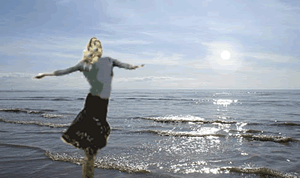Positive Health Online
Your Country

Seasonal Affective Disorder: Symptoms, Prevalence and Treatments
listed in sad, originally published in issue 155 - February 2009
Are you dreading winter? The craving for sweets? The loss of your sex drive?
You are not alone. Seasonal Affective Disorder, appropriately knows as 'SAD', strikes ten million Americans and more than four million people in the UK every year. Another 25 million Americans and over ten million Brits may have a milder form of SAD called the 'winter blues' or the 'winter blahs'. SAD also tends to run in families, so researchers suspect that a genetic component may be involved.

So What is Seasonal Affective Disorder?
In 1898, the arctic explorer Fredrick Cook made the following observations while in the far north:
"The winter and darkness have slowly but steadily settled over us. It is not difficult to read on the faces of my companions their thoughts and moody dispositions. The curtain of blackness that has fallen over the outer world of icy desolation has also descended upon the inner world of our souls. Around the tables, men are sitting about, sad and dejected, lost in dreams of melancholy from which, now and then, one arouses with an empty attempt at enthusiasm. For brief moments, some try to break the spell by jokes, told perhaps for the fiftieth time. Others grind out a cheerful philosophy, but all efforts to infuse bright hopes fail."
Anyone with Seasonal Affective Disorder can empathize with these men.
People with SAD experience lethargy, daytime drowsiness and a marked craving for sweet or starchy foods. Those with SAD also experience social withdrawal and decreased work performance. Almost everyone experiences some changes in feelings of well-being or behaviour when the seasons change, but the person afflicted with Seasonal Affective Disorder dreads the shorter days that occur as fall and winter approach.
Seasonal Affective Disorder is not the same as depression. Depression can usually be successfully treated with medication and with the intervention of a mental health specialist; patients with SAD usually do not respond to the medications used for depression. In addition, SAD should not be confused with the so-called 'holiday blues' or 'Christmas depression' that many people experience in December. Sadness that develops during these periods usually arises when bad memories or loneliness conflict with the sense of joy that others seem to be experiencing. People with SAD are suffering from the lack of daylight that occurs during winter, and this seasonal change can be a real problem for these people.
Most people who suffer from SAD can remember problems during the winter months extending all the way back to their childhood. During the bright summer months, they were creative and energetic; however, once the winter months came on, they had problems concentrating; they gained weight and usually overslept. Criticism from school teachers was not uncommon during the winter months; lack of attention, decreased concentration and the inability to complete homework assignments were common complaints. These problems tended to disappear during the sunny summer months. Some people with SAD are not limited to experiencing symptoms during the winter months; some experience SAD symptoms during the summer when there are several overcast days in a row.
Many therapies have been tried for the treatment of SAD. For years, the cause of SAD has been suspected to be a problem with the secretion of a brain chemical called melatonin. When light enters our eye, it strikes the retina, a collection of cells on the back wall of our eyeball. The retina then converts the light to an electrical signal that travels to a deep part of our brain called the SupraChiasmatic Nucleus (SCN), which is located in the hypothalamus. The SCN then send messages to the other glands in our body, such as the pineal and pituitary glands in our brain, the adrenal glands on top of our kidneys and the thyroid gland in the front of our neck. The secretion of melatonin is controlled by the pineal gland that is located deep in our brain; the longer and brighter the daylight, less melatonin is secreted, while more melatonin is secreted during the periods of less sunlight. When the gland starts secreting too much melatonin, people get sleepy. It has been noted that in animals the secretion of melatonin is greater during the winter.
Minimizing Effects of SAD
Many medications have been tried to ameliorate the symptoms of SAD, but most have had limited effect. Psychotherapy may help those with concurrent personal or behavioural issues, but such therapy is of limited use for symptoms related to SAD. Some studies have shown that the incidence of Seasonal Affective Disorder is low in Iceland and Japan, and speculation exists that this may be due to the high consumption of fish. In a survey of adults in Finland, one researcher demonstrated that the likelihood of having depressive symptoms was significantly higher among infrequent fish consumers than among frequent consumers. Further research is needed in this area to determine if such an actual correlation exists.
There are other things you can do you minimize the effects of SAD. Many people find relief by staying physically active during the winter, so plan some physical activity outdoors when the sun is up. Expose yourself to as much light as you can by staying outside during daytime and also use as much indoor lighting as you can.

How one perceives winter can have an effect on one's mental state. If you hate winter, then you may be predisposing yourself to SAD-like symptoms. Trying to change your mind-set about winter may be difficult, and may require the intervention of a mental health specialist.
If you feel that you are becoming depressed as winter progresses, see your health care provider or mental health specialist. It is much easier to treat the symptoms of SAD when they start than when they have become severe. And keep in mind that it may be possible you don't have SAD; you may have another mental health issue (like depression) which is generally amenable to treatment with medication and therapy by a mental health specialist.
Light Therapy
The most effective method for the treatment of SAD is light. Research has shown that it is the light that reaches the eye that decreases the symptoms of SAD, not the light that reaches the skin. This contradicts the common misperception that tanning beds can be an effective treatment for SAD. When using a tanning bed properly, the eyes should be covered with dark glasses; this negates the supposed benefit of the light from the tanning bed. Tanning beds are also a well-known breeding ground for potential skin cancer as one ages.
Simply sitting in front of a bright light fixture while reading or working can help; however, it has been found that the brighter the light, and light of certain wavelengths, is the best for treating SAD. As a rule, the treatment time decreases as the amount of light increases. The amount of light given off by a fixture is measured in 'lux'** For example, a bedroom illuminated by a single bedside lamp has a light level of about 100 lux. Indoor lighting measures about 300 to 500 lux, whereas a well-lit office may measure 500 to 1,000 lux. Using light for the treatment of SAD generally requires the use of a 'light box' that can emit up to 10,000 lux (though the intensity decreases rapidly as the distance between the light source and person increases). Some more sophisticated light boxes include a 'sunrise simulator' that a person can use to determine what time 'dawn' starts; the user simply programs the unit to slowly brighten in the morning - this simulates the rising of the sun and also allows adjustment of the time from 'dawn' to full intensity. This device can be useful for those afflicted with SAD, but still must be up before the rising of 'the real' sun. Light visors are also available; these portable devices are worn just like a baseball cap, and are useful if one's activities preclude sitting in one place for a long period of time.
How long each light session lasts depends on the patient. Some people get along very well with one 30-minute session a day, while others may need two or three sessions a day. Some people feel improvement in their symptoms after three or four sessions, while others may not notice improvement for several weeks. Light boxes are also generally portable - you can put one on your desk while you are working during the day, and take it home at night.
People taking medication should talk to their health care provider prior to starting light therapy because some medications can cause the eyes or skin to become sensitive to light. It is also a good idea to have your eyes checked by an optometrist or ophthalmologist prior to beginning light therapy, and then on a regular basis after light treatment begins. Patients with medical issues that predispose them to skin problems, such as lupus or a history of skin cancer, should check with their health care provider prior to starting light therapy. Also, while under light treatment, one should have their skin checked regularly by their health care provider. If light therapy does not seem to help, one should consult a mental health specialist to determine if there is some other psychological issue going on. Though medications cannot directly treat Seasonal Affective Disorder, medications can help with the sleepiness and depression that often accompany SAD.
Side-effects of light therapy are manageable. Some people experience headaches, eyestrain or nausea. Others can become agitated when exposed to therapeutic level of light. All these side- effects are generally mild and temporary and disappear with regular use, or a decrease in the amount of light used. Some researchers have claimed success with treating SAD with exposure of light to the skin, namely the skin in the popliteal (behind the knee) area; however, other researchers have had difficulty replicating these experiments, so further research is needed.
Seasonal Affective Disorder can be a real problem, but once recognized and acknowledged, treatment can make life fun again.
Note
**It is difficult to directly convert watts to lux (or vice-versa) because one has to determine what wavelength of light is being measured.
New Research
In a study published in the December 2006 issue of the American Journal of Psychiatry, Drs Michael Terman and Jiuan Su Terman discovered that the use of high-density negative ions may have an anti-depressant effect on those suffering from SAD; some of the experiments showed improvement of mood when the ions were used during sleep. Further research is needed to determine if ion therapy can be used in conjunction with, or even instead of, light therapy. This may give the person who suffers from Seasonal Affective Disorder another treatment option.
Further Information and Resources
- Light Therapy Products 5623 Memorial Ave, Stillwater MN 55082 offers full-spectrum lighting products. They can be contacted at 651.351.9800; www.lighttherapyproducts.com/
- In the United Kingdom, the Environmental Illness Resource Centre offers full-spectrum lighting products. They can be contacted at +44 1 1423 528055; www.ei-resource.org/
- The National Organization for Seasonal Affective Disorder (NOSAD) is a support group in the United States for those who suffer from SAD. Their website is http://www.nosad.org. The Seasonal Affective Disorder Association (www.sada.org.uk/) is a support group in the UK.
- Winter Blues: Seasonal Affective Disorder: What It Is and How To Overcome It. Norman Rosenthal, MD. 1993: Guilford Press, 72 Spring Street, New York, NY 10012. This book goes into great detail about SAD and is a must for anyone with the problem.
Comments:
-
No Article Comments available